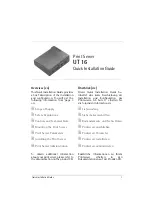
158004.B00
9
before or during the memory test to enter the Setup program, where you can change
the time and date and make other changes. The "EXIT" menu option allows you to
save the settings in CMOS RAM and exit.
While using the TCDEVPLUS’s floppy disk controller the BIOS will print a warning
message to the effect that it is disabling the floppy disk controller on board the
TP400.
You should now boot DOS from the floppy disk drive on the TCDEVPLUS.
An alternative to using floppy disks is to make use of the hard disk present on the
TP400 or the TCDEVPLUS. You may connect an IDE drive, or Compact Flash card
installed in the CF100 adapter, to the 44-way IDE connector J100 on the TP400. The
BIOS will automatically detect the drive’s parameters.
Alternatively, you may use the IDE controller on the TCDEVPLUS. This allows you to
connect to both 2.5” and 3.5” IDE drives, and to make use of the Compact Flash
socket on the TCDEVPLUS. To use the TCDEVPLUS IDE controller you must enable
it at jumper E4, and use the BIOS Setup program to disable the TP400’s on-board
IDE controller.
(The IDE disk controller on the TCDEVPLUS is slower than the controller on the
TP400, but it offers the convenience of the wider range of connectors. In principle it is
possible to use a 44-way cable to connect the TP400’s IDE controller to the
TCDEVPLUS PCB, to take advantage of the wider range of connectors on the
TCDEVPLUS PCB, while using the faster TP400’s IDE controller. Unfortunately, if
you want to do this with the REV B TCDEVPLUS you must cut pin 32 of the ribbon
cables. The REV C TCDEVPLUS provides links to do this.)
Section 3.9 has more details on the IDE interface. A Flash File system is also
provided with the TP400. Section 6.6 has details of the Flash File System.
When you want to use the TP400's on-board floppy and graphics controllers then you
may make the appropriate connections to the TP400's connectors and disable the
corresponding TP400 device at the TCDEVPLUS jumper areas E3 and E5. To
disable the TCDEVPLUS's VGA chip you must also set the E6 jumpers all to the
"DIS" position.
When development is complete the TP400 is removed from the TCDEVPLUS
Development System. It can then operate stand-alone, or be used with other PC/104
modules.
Refer to the TCDEVPLUS Technical Reference Manual for full details of the
TCDEVPLUS.
1.6.3 Using the Rev D TCDEV Development System
To use the system, first install an SDRAM SODIMM module into the TP400 SDRAM
socket, observing its polarity, and observing proper anti-static precautions. The
SODIMM socket has a lug that engages with a cutout on the module, which prevents
incorrect installation.
Summary of Contents for 104-plus
Page 2: ... This page is intentionally left blank ...
Page 4: ... This page is intentionally left blank ...
Page 76: ...66 158004 B00 This page is intentionally left blank ...
Page 86: ...B8 158004 B00 This page is intentionally left blank ...
Page 88: ...C2 158004 B00 FIGURE C1 MAIN BOARD TOP COMPONENT PLACEMENT ...
Page 89: ...158004 B00 C3 FIGURE C2 MAIN BOARD BOTTOM COMPONENT PLACEMENT ...
Page 90: ...C4 158004 B00 FIGURE C3 DAUGHTER BOARD TOP COMPONENT PLACEMENT ...
Page 91: ...158004 B00 C5 FIGURE C4 DAUGHTER BOARD BOTTOM COMPONENT PLACEMENT ...
Page 92: ...C6 158004 B00 FIGURE C5 MAIN BOARD MECHANICAL DIMENSIONS ...
Page 93: ...158004 B00 C7 FIGURE C6 DAUGHTER BOARD MECHANICAL DIMENSIONS ...
Page 94: ...C8 158004 B00 This page is intentionally left blank ...
Page 100: ...D6 158004 B00 This page is intentionally left blank ...
Page 116: ...E16 158004 B00 This page is intentionally left blank ...
Page 134: ...H6 164004 C03 This page is Intentionally left blank ...
Page 136: ...J2 164004 C03 FIGURE J1 TP400ET MECHANICAL DRAWINGS FIGURE J2 TP400ET CIRCUIT DIAGRAM ...
Page 138: ...K2 158004 B00 FIGURE K1 TP300USB MECHANICAL DRAWINGS FIGURE K2 TP300USB CIRCUIT DIAGRAM ...
















































